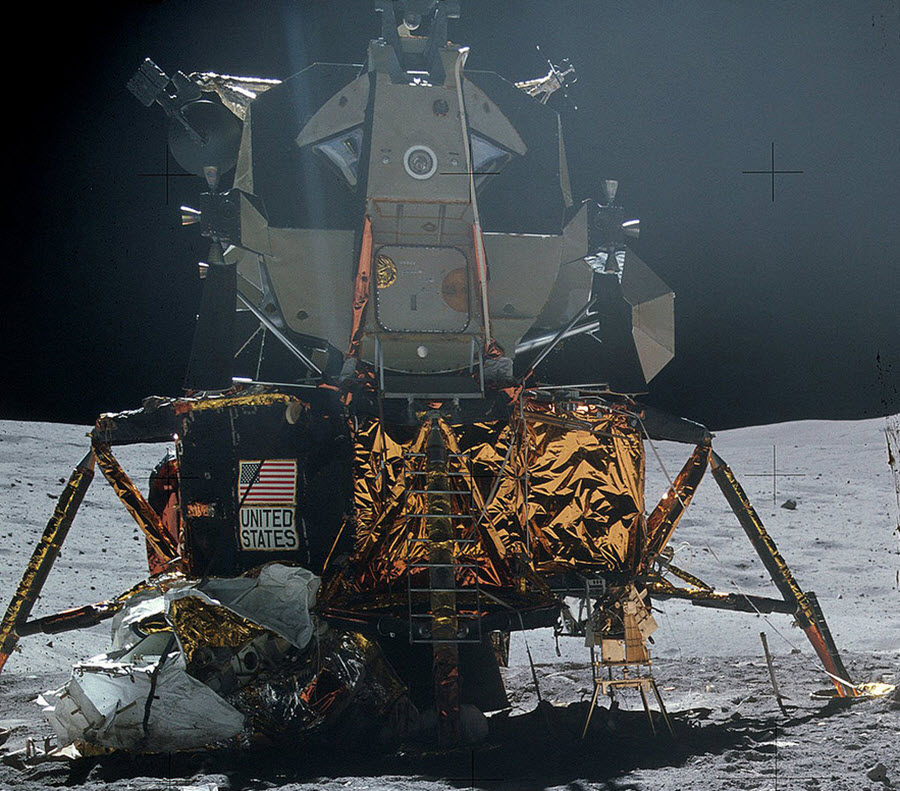The Lunar Module (LM) was originally called the Lunar Excursion Module (LEM). It is still called “LEM” even after the name has been changed.
The Lunar Module was the spacecraft that enabled the Apollo astronauts to land on the moon. It was built by Grumman Aerospace on Long Island, NY.

The module
It consisted of two important parts: the descent step and the ascent step.
It travelled with the separate spacecraft Command Service Module to the moon’s orbit. The Command Service Module was about twice the size of the Lunar Module.
The Lunar Module was about 5.5 meters high and about 4.3 meters in diameter.
Use
It was tested during the Apollo 9 mission by flying in Earth’s orbit and then during the Apollo 10 mission it was tested in lunar orbit. It was Apollo 11 who got the chance to use it all the way when they landed on the moon in July 1969.
Between 1969 and 1972, the Lunar Module landed six times on the moon. There was only room for two people in it so one of the three astronauts had to stay on the Commander Service Module.
After each use, the Lunar Module was discarded.
It only worked in outer space. structurally and aerodynamically, it could not fly through the Earth’s atmosphere. It was the most reliable module during the Apollo missions; no Lunar Module was affected by any errors that jeopardized the missions.
During the Apollo 13 crisis, the Lunar Module managed to keep the astronauts alive after an explosion that damaged the Apollo Command Service Module.
Several models
The Lunar Module was updated over the years between space travels and the last three that landed on the moon were more advanced than the original. It was given the nickname Moon Buggy and made it possible to extend the time for the moon walks.
Names
All the Lunar Modules that were used were given a name during the missions.
- Apollo 9 – Spider
- Apollo 10 – Snoopy
- Apollo 11 – Eagle
- Apollo 12 – Intrepid
- Apollo 13 – Aquarius
- Apollo 14 – Antares
- Apollo 15 – Falcon
- Apollo 16 – Orion
- Apollo 17 – Challenger
The Lunar Module were placed under the Command Service Module with recessed legs at launch.
Landing on the moon
During the flight to the moon, the dock hatches were opened so that the Lunar Module pilot could go in to turn on and test the systems. Once they had found a place to stay in the lunar orbit, the Lunar Module was started by the commander and the Lunar Module pilot.
They replaced the hatches and docking equipment. Then they could unfold and lock the landing legs. They were then separated from the Command Service Module and could fly away on their own. The astronaut who remained in the command service module inspected The lunar module landing gear.
The Lunar Module pulled back to a safe distance from the Command Service Module and let the descent engine perform a 30-second burn to reduce speed and get close to the moon’s surface.
Then they started the engine again to slow down to almost zero. During the last approach, the Lunar Module was tilted so that it was in an almost completely vertical position. The crew could then look down towards the surface of the moon.
The commander took control of the craft and hovered for about two minutes to be able to make some final adjustments before landing. Finally, the long probes extending from the footplates on the lander surface, the descent engine were turned off and the Lunar Module was able to land.
Leaving the moon
When they were about to leave the moon, the descent step was used as a launching platform and fired the ascending engine to return to the moon’s orbit. Then the Lunar Module docked with the Command Service Module so the crew could leave the moonlander. When the Lunar Module was released from the Command Service Module, it either flew on in the moon’s orbit or crashed into the moon.